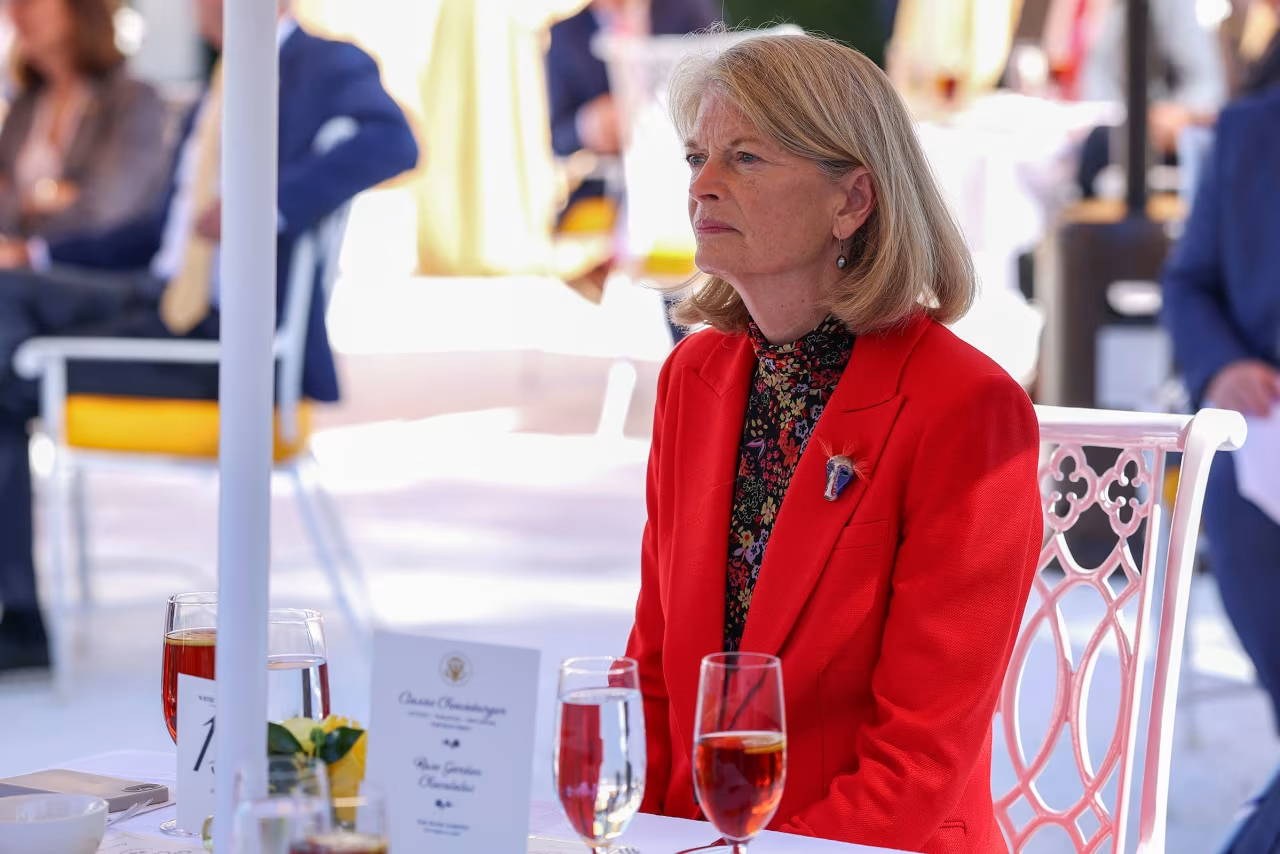What we're covering
• Shutdown stalemate: Senators are returning to Washington on Monday with no end to the federal government shutdown in sight as the impacts of the impasse continue to be felt. Democrats are signaling there will be no change in strategy over their health care position as they hammer President Donald Trump for his failure to sit down and negotiate with their party.
• Trump meets with Japan’s emperor: Meanwhile abroad, Trump is in Japan, the second stop of his Asia diplomacy tour, where on Monday he visited Emperor Naruhito at Tokyo’s Imperial Palace. On Tuesday local time, he’ll meet with Japan’s first female prime minister, Sanae Takaichi, and speak to US troops aboard the USS George Washington.
• Possible US-China trade deal: In Malaysia, US-China trade negotiators reported major progress on a potential deal, easing tensions before Trump’s expected meeting with Chinese leader Xi Jinping later this week. Trump said he is open to extending his trip to meet with North Korean leader Kim Jong Un, though there are no known scheduled plans for talks.
Murkowski joins Senate and House Democrats on amicus brief challenging Trump's tariffs

Sen. Lisa Murkowski of Alaska is the sole Republican to sign on to an amicus brief from Senate and House Democrats challenging President Donald Trump’s use of the International Emergency Economic Powers Act to enact tariffs.
Murkowski is one of 34 senators and 171 House members to sign on to the brief, which was filed in the consolidated case before the Supreme Court targeting the Trump administration’s implementation of tariffs without congressional approval.
Some more background: In September, Trump urged the Supreme Court to step into the fray over his emergency tariffs, putting the centerpiece of his economic agenda in the hands of the justices who have mostly backed his sweeping view of executive power.
Trump is pressing the justices to overturn a lower court ruling that found his administration acted unlawfully by imposing many of his sweeping import taxes, and he has framed the case in existential terms.
CNN’s John Fritze and Elisabeth Buchwald contributed reporting to this post.
Johnson defends keeping House out of session as shutdown continues

Speaker Mike Johnson on Monday fiercely defended keeping the House out of session for over a month, contending Republican lawmakers were accomplishing critical work in their districts.
Pressed by CNN on not calling members back to Washington, the speaker said they were “evaluating” the matter “day by day.” But he maintained there couldn’t be regular legislative session as long as the government remained closed, and said Republicans in the meantime were accomplishing critical work for constituents in their districts.
“I don’t know what the Democrats are doing other than publicity stunts, but I can tell you the House Republicans, they’re doing some of the most meaningful work of their careers,” he said. “They’re in their districts, working around the clock with their constituents, helping them not only to negotiate the crisis that’s been created by this Democrat shutdown, but all the other matters that they need to attend to.”
He later said, “So I don’t want to pull them away from that work right now when their insight and their counsel and their assistance and those of their staff, who by the way, aren’t getting paid soon, that is most essentially needed right now back home.”
The House can be in legislative session even during a government shutdown, and can complete committee meetings and hearings, and vote on bills.
US-Mexico trade deadline extended by "a few more weeks," Sheinbaum says

Mexican President Claudia Sheinbaum said Monday that after speaking with President Donald Trump over the weekend, the two leaders have agreed to extend trade talks for “a few weeks.”
Her announcement comes days ahead of the expiration of the 90-day pause on higher tariffs that the two leaders set in July. That deadline has been extended several times since Trump’s second term began.
Goods from Mexico are still being tariffed at 25%, but only if they don’t comply with the United States-Mexico-Canada Agreement. Otherwise they can be shipped to the US duty free.
“So, we agreed to speak again in a few weeks because we are practically closing this issue, since the deadline we both set of three months finally ends on November 1,” Sheinbaum said during a news conference earlier. She said her conversation with Trump was “very brief.”
“We essentially only talked about the trade issue, and agreed that work will continue,” she said.
Air traffic controllers brace for first missed payday of shutdown

As air traffic controllers brace for Tuesday’s payday — the first since the start of the 27-day shutdown where they will get no pay — union leaders worry, “Where’s the breaking point?”
The job, with lives on the line, is stressful enough, but adding financial problems and other worries makes it more difficult, Dan McCabe, southern regional vice president of the National Air Traffic Controllers Association, said on “CNN News Central.”
“Tomorrow is the day — the first zero paycheck that introduces a whole new litany of issues — putting gas in your car, making sure your kids are taken care of, making sure that you can eat,” he said. “What we have to look at now, where is the breaking point for each individual and that stress is absolutely unnecessary on top of what they’re already doing?”
This comes after a weekend of staffing problems, caused by not enough controllers reporting to work, that triggered delays all over the country. Air traffic controllers are considered essential workers, so they must work during the shutdown, but are not being paid.
Despite the problems, McCabe says a margin of safety will always be the priority.
“When the capacity is lowered because of some outside influence, weather, construction, staffing — we do have to downshift the airplanes to be able to keep that margin of safety, and we don’t allow that margin of safety to shift at all,” McCabe said.
FAA staffing problems Monday cause delays at Los Angeles International airport
Travelers may experience delays today at some US airports as the Federal Aviation Administration continues to report staffing issues as the government shutdown drags on.
Air traffic controller staffing problems caused delays Monday at Los Angeles International airport (LAX), according to a FAA advisory.
The delay program will last until 4 p.m. ET and currently averages less than a half hour per flight.
The problems come after LAX, and many other FAA facilities, saw delays over the weekend. More than 50 staffing shortages were reported between Friday morning and Sunday night, the most since the start of the government shutdown.
The TRACON facility that handles flights approaching and departing Newark Liberty International Airport is short staffed until 11 a.m. ET. The TRACON for Atlanta is also understaffed until 12:30 p.m. ET.
Not every staffing shortage results in a delay, as controllers can reroute flights, but sometimes there is no choice but to slow planes down to maintain safety.
At least 267 air traffic controller staffing shortages have been reported since the start of the shutdown, more than four times the number reported in the same days last year.
Remember: Controllers are considered essential staff and must work during the shutdown, despite not being paid. Transportation Secretary Sean Duffy said some have called in sick in protest while others are taking time to work other jobs.
China's foreign minister speaks with Rubio in call ahead of anticipated Trump-Xi meeting

We’re hearing more from Chinese leaders ahead of the highly anticipated meeting between President Donald Trump and President Xi Jinping that is expected to happen later this week.
China hopes that the US can work with them to “prepare for high-level interactions” between the two nations, Foreign Minister Wang Yi said in a phone call with US Secretary of State Marco Rubio today, according to Chinese state-run media Xinhua.
He said that “a healthy, stable and sustainable bilateral relationship serves the long-term interest of both countries” and described Trump and Xi as “world-class leaders who have engaged with each other over a long period and with mutual respect.”
Wang acknowledged trade relations between the world’s two biggest economies had recently “experienced turbulence,” but said yesterday’s framework agreement on trade reached by US and Chinese officials showed “it is possible to stabilize and move the bilateral relationship forward.”
The readout of the call was yet another positive signal that a Trump-Xi meeting could be on the cards later this week. The White House has said the two leaders will meet on the sidelines of the Asia-Pacific Economic Cooperation CEO summit in South Korea on Thursday. Beijing has yet to confirm the meeting.
Trump arrived in Japan earlier on Monday, the second leg of a weeklong diplomacy tour in Asia.
CNN’s John Liu contributed reporting.
The government shutdown enters yet another week — with no signs of ending. Here’s where things stand

Our coverage of the government shutdown continues today as senators return to Washington with no end to the federal government shutdown in sight.
Many federal workers have now officially missed a paycheck and are finding themselves struggling to make ends meet. More than 1 million federal workers are going unpaid while funding is also dwindling for a critical food assistance program as the stalemate in Congress persists.
CNN’s team of reporters on Capitol Hill will be tracking the latest on the impasse today. As the new week kicks off, read up below on where things stand:
- Senators return: Having left Thursday without reaching a deal on funding the federal government, the Senate is expected to reconvene today at 3 p.m. ET. As of this morning, a vote on a funding bill has not been scheduled. Democrats are signaling that there will be no change in their strategy – they won’t provide the votes to reopen the government unless their demands over health care are met.
- Bill to pay essential workers fails: Last week, Senate Democrats blocked a GOP-led bill to pay workers who are deemed essential during the shutdown. Many Democrats have said they want to pass a bill that also pays furloughed federal workers, though Republicans rejected their alternatives. Here’s a breakdown of who’s getting paid — and who’s not during the shutdown.
- GOP expresses concern about health care: Anxiety is rising among congressional Republicans that their party has no plan to address a critical health care deadline this fall that will result in spiking costs for millions of Americans — the issue at the heart of the deepening shutdown crisis.
- No contingency fund for SNAP benefits: The US Department of Agriculture says it will not use its $6 billion contingency fund to cover food stamp benefits next month if the shutdown continues, according to a statement on the official USDA website.
- Travel troubles: Flight delays and cancellations will increase as shutdown-related staffing shortages worsen, Transportation Secretary Sean Duffy said on Fox News’ “Sunday Morning Futures with Maria Bartiromo.” Meanwhile, the Federal Aviation Administration reported delays yesterday at airports from Los Angeles to Washington, capping the worst weekend for staffing shortages since the start of the shutdown.
CNN’s Sarah Ferris, Ellis Kim, Manu Raju, Aaron Cooper, Alejandra Jaramillo, Alison Main, Jenna Monnin and Matt Meyer contributed reporting to this post.
Analysis: While Trump's in Asia, he’s beating war drums in Latin America

It doesn’t take America’s most lethal aircraft carrier, its F/A-18 jets and a flotilla of US Navy warships carrying dozens of Tomahawk missiles to blast a few speedboats out of the Caribbean.
So as the USS Gerald R. Ford steams from Europe to join an already formidable US naval and air force in the region, expectations are rising that the Trump administration may escalate what it claims is an assault on drug traffickers.
The first target of this new 21st-century gunboat diplomacy is Venezuelan President Nicolás Maduro, an election-denying dictator. The Ford will deliver a giant hint to Maduro to go, or for Venezuelan army officers to oust him. Or it could serve as the platform not just for attacks against alleged cartel targets but also to change the regime.
Top Trump aides have portrayed Venezuela as a major route for fentanyl and other drugs that kill Americans, even if evidence shows little drugs production in the country and far more significant transit routes elsewhere. They claim Maduro is at the head of a network of cartels. The administration has authorized the use of military force against such groups and declared gang members “unlawful combatants,” seeking to legally justify killings that that deny due process.
President Donald Trump is considering plans to target cocaine facilities and alleged drug trafficking routes inside Venezuela, three US officials told CNN last week, but has not ruled out diplomacy. He’s also relishing a string of strikes against what officials claim are cartel boats. He might be in Asia, but there’s a rising drumbeat of war closer to home.
Catch up on Trump’s events Monday in Asia

US President Donald Trump arrived here in Tokyo Monday evening local time after a six-hour flight from Malaysia and a 30-minute in-flight gaggle. He was received by Emperor Naruhito at the Imperial Palace for what the White House described as a “courtesy call” before retreating to his hotel for the evening.
Looking ahead to Tuesday: Trump is set to meet Japan’s new, conservative prime minister in the morning local time. In the afternoon, he’ll visit with US troops aboard the USS George Washington and give a speech. He’ll dine with business leaders in the evening.
While you were sleeping: The president spoke to reporters on the way to Tokyo. Here are the highlights:
- He announced he had an MRI during his trip to Walter Reed – raising new questions about his health and providing details about his second medical exam this year.
- He said he was “very much opposed” to his administration’s handling of an ICE raidat a Georgia Hyundai plant – an olive branch ahead of his trip to South Korea later this week.
- He said he’s open to extending his trip to meet with Kim Jong Un but didn’t have any new details about a potential meeting.
- He continued to lash out at Canada but wouldn’t say when the new 10% tariffs would go into effect.
- He waved off reports of Russia testing a nuclear-powered missile, saying on Monday that the US also had nuclear submarines located close to Russia.
- He suggested he would make a decision on a Fed Chair replacement before the holidays.
- He said a TikTok deal could be signed on Thursday.
- He again raised the possibility of a third term in office.
Trump doesn't rule out running for a third term, but wouldn’t run as vice president

President Donald Trump would not rule out running for a third term, telling reporters he “would love to do it,” while also floating the possibility of a Vice President JD Vance and Secretary of State Marco Rubio pairing in 2028.
“I haven’t really thought about it; we have some very good people as you know,” Trump said, as Secretary of State Marco Rubio looked on in the doorway behind him on Air Force One. “I have the best poll numbers I’ve ever had. I mean, I just solved eight wars, and I believe a ninth is coming. I believe Russia-Ukraine will happen.”
Trump name-dropped Vance and Rubio, when asked about the “good people” he has in mind for the Republican ticket in 2028.
While Trump praised the pair in his administration, at the same time, he said, “I would love to do it, you know, I have my best numbers ever. It’s very terrible.”
Pressed by a reporter if he’s not ruling out a third term, Trump said, “Am I not ruling it out? You’ll have to tell me. All I can tell you is we have a great group of people, which (Democrats) don’t.”
When presented with the idea that he could run as vice president to serve another term, Trump, however, didn’t entertain it: “I’d be allowed to do that,” Trump said. “But I wouldn’t want to — I wouldn’t do that.”
Some more context: At the White House, Trump has joked about running for a third term and Trump 2028 hats are on display in a room near the Oval Office. Recently, Trump posted images of the ’28 hats on the Resolute Desk when the House and Senate minority leaders, Hakeem Jeffries and Chuck Schumer, came to the Oval Office.
Back in the US, a union president says it's "past time" to end shutdown

Back in the US, the government shutdown is dragging on into another week with the president of a union representing hundreds of thousands of government employees saying in a statement today that it is “past time” to end the stalemate.
AFGE represents more than 800,000 workers spread across the DC and federal governments.
“It’s long past time for our leaders to put aside partisan politics and embrace responsible government,” Kelley added.
Kelley called for lawmakers to reopen the government immediately while ensuring back pay for workers who were furloughed.
Some context: More than a million federal employees are going unpaid while Democrats and Republicans in Congress continue arguing over funding the government.
Japan's emperor greets Trump, kicking off Tokyo leg of his trip
President Donald Trump visited with Emperor Naruhito of Japan on Monday for what the White House described as a courtesy visit, kicking off a series of warm welcomes in Tokyo.
The visit offered rare access to the emperor’s residence, a simple building made of vast concrete with large windows overlooking a foyer with meticulously-pruned bonsai trees.
The emperor smiled and offered a wave to the US president. Trump, dressed in a navy suit and gold tie, emerged, excitedly gestured and warmly greeted the emperor. They shook hands and exchanged pleasantries. The two then turned to the cameras and smiled for a photo, Trump fiddling with his suit jacket button briefly. Then they turned to walk inside the residence. Trump briefly put his hand on the emperor as they walked inside.
The emperor previously hosted Trump for a banquet during a state visit in 2019.
The two leaders emerged after more than half an hour inside, with Trump calling the emperor “a great man.”
This post has been updated with additional developments.
Will Trump meet with North Korea's leader?
President Donald Trump said he is open to extending his Asia trip to meet with North Korean leader Kim Jong Un, though there are no known scheduled plans for talks.
Trump administration officials have privately discussed setting up a meeting between the leaders, though many are skeptical that it will happen, sources told CNN before the trip.
In Trump’s first term, officials arranged a handshake between the two men in the Korean demilitarized zone less than 48 hours after the president tweeted an invitation to get together — an example of how quickly things can change.
CNN’s Will Ripley broke down the possibility of the leaders meeting this week:

President Donald Trump says he would like to meet with North Korean leader Kim Jong Un during his trip to Asia. But is that logistically possible? CNN's Will Ripley explains why he's feeling a bit of deja vu.
Trump arrives in Japan on second leg of three-stop Asia tour
President Donald Trump has arrived in Tokyo, Japan, his second stop on a three-country tour of Asia.
Air Force One was wheels down at Haneda airport at 5 p.m. local time (4 a.m. ET) on Monday.
“Looking forward to seeing the Emperor!” Trump said in a Truth Social post just before he landed. He’s expected to meet Emperor Naruhito, who has been Japan’s monarch since 2019, soon.
After the president walked off Air Force One on arrival in Tokyo, he shook hands with a number of US and Japanese officials waiting on the ground – including Japan’s chief cabinet secretary, the US ambassador to Japan, and the commander of US forces in Japan.
Trump then stepped onto the Marine One presidential helicopter and departed the airport for Tokyo’s Imperial Palace, a 10-minute flight away.
Here in Tokyo, he’ll also meet with Sanae Takaichi, a staunch conservative and protege of the late Shinzo Abe, who became Japan’s first female prime minister this month.
Trump is likely to highlight Japan’s commitment to invest $550 billion in the US. He is also expected to meet with Japan’s emperor, visit with US troops, and meet Japanese business leaders during the trip.
CNN’s Jessie Yeung contributed to this post.
Chinese bombers conduct "confrontation drills" near Taiwan, days before expected Trump meeting with Xi
China sent a group of H-6K strategic bombers near Taiwan for “confrontation drills,” Chinese state media reported late Sunday, just days ahead of an expected meeting between US President Donald Trump and China’s leader Xi Jinping.
H-6K bombers are capable of carrying nuclear weapons.
Without specifying a date, the Chinese state television’s military channel reported that air force units of the Chinese military’s Eastern Theater Command – responsible for operations around Taiwan – conducted combat training that focused on reconnaissance, early warnings, air blockades and precision strikes in key areas.
The report aired footage of the J-10 fighter jets taking off, and H-6 bombers releasing missiles. A Chinese soldier was quoted as saying “Taiwan’s coast line is clearly visible up in the (air).”
Taiwan’s Defense Ministry publicizes daily updates on Chinese military activities around the island’s waters and airspace. On Monday morning, the ministry said four sorties of Chinese aircraft were detected, without specifying any abnormalities.
The ministry said in a statement that the Chinese report was “clearly a public-opinion operation aimed at intimidation.”
Some context: China regularly sends its fighter jets, drones and warships to airspace and waters around Taiwan, and in recent years has ramped up military, diplomatic and economic pressure on the self-ruled island democracy, which Beijing claims as its own – despite having never ruled over it.
The US maintains close unofficial ties with Taiwan, and is bound by law to sell arms to the island for its self-defense, but it remains deliberately vague on whether it would intervene in the event of a Chinese invasion.
Trump says he was "very much opposed" to handling of ICE raid at Hyundai plant

President Donald Trump said Monday he was “very much opposed” to his administration’s handling of a September immigration raid at a Hyundai plant, offering an olive branch ahead of his trip to South Korea later this week.
The US-South Korean relationship faced a major test when nearly 500 people, mostly South Korean nationals, were arrested and detained during the immigration raid at a plant in the US state of Georgia, sparking outrage in South Korea. The detained South Korean workers were returned to their home country on a chartered flight following negotiations.
Trump said his administration wants other countries investing in the US to “bring in experts.”
Pressed on whether he was opposed to the raid, Trump said he “was opposed to getting them out. And in fact, before they got out, they were pretty well set… I said they could stay… and they’re going to be coming back.”
After the raid, President Lee Jae Myung openly expressed concern about the future of South Korean investment in the US, saying that confusion over the visa situation would lead local companies to question “whether they should go at all.”
Trump received an MRI during trip to Walter Reed, he says
President Donald Trump told reporters that he received an MRI scan during a recent trip to Walter Reed, the first time he has provided details of the tests in his second medical exam this year and raising new questions about the president’s health.
“I did. I got an MRI. It was perfect,” Trump told reporters aboard Air Force One Monday.
Trump, who at 79 is one of the oldest presidents in US history, declined to say why he received the MRI during the Walter Reed visit earlier this month, telling reporters to “ask the doctors.”
The president claimed that his doctors offered reporters a “very conclusive” report of the exam, but the White House has not previously disclosed the reason for his unusual second visit, a departure from the traditional presidential cadence of a single comprehensive exam per year.
This summer, the White House announced that Trump was examined for swelling in his legs and has been diagnosed with chronic venous insufficiency. Trump has also faced scrutiny over regular bruising on his right hand that he’s appeared at times to cover up with heavy makeup. The White House physician, Dr. Sean Barbabella, has attributed it to a combination of “frequent handshaking” and aspirin use, which can increase bruising.
Trump says he is open to extending his Asia trip to meet with Kim Jong Un

US President Trump said he would “love to see” North Korean leader Kim Jong Un during his Asia trip, though there are no known scheduled plans for a meeting.
Trump will be visiting South Korea later this week, where he will join the Asia-Pacific Economic Cooperation (APEC) CEO summit.
When asked if he would consider extending his trip to facilitate a possible meeting with Kim, Trump suggested he was open the that.
A reporter then asked what the US can offer North Korea as incentive to engage.
“I just have a good relationship with him, I would love to see him.”
The two leaders met during Trump’s first term in office, which saw a series of unprecedented meetings in 2018 and 2019. During one meeting in the demilitarized zone (DMZ) between North and South Korea, Kim invited Trump to step over the border into North Korea – making him the first sitting US president to enter the highly isolated autocratic nation.
But the talks ended without any breakthrough, and efforts at denuclearization or peace negotiations fizzled out afterward.
Trump continues to lash out at Canada, but won’t say when new tariffs will go into effect

President Donald Trump has declined to say when his newly threatened tariff on Canada would go into effect, as he continues to vent his frustration with the United States’ northern neighbor.
Trump previously said this weekend he would be increasing tariffs on Canada by 10% over what he called the “fake” ad that featured parts of an anti-tariff speech by former President Ronald Reagan in 1987.
Trump was pressed by a reporter on the ad, which was purchased by the government of Ontario and broadcast on major US television networks, and claimed that the country’s prime minister, Mark Carney, was aware of it.
“Whether it’s provincial or Canada itself, they all knew exactly what the ad was. The prime minister knew. Everybody knew,” Trump said aboard Air Force One, en route to Japan — the next stop on his Asia tour.
Asked whether he would be open to meeting with Carney, Trump said:
Trump says Putin should focus on ending Ukraine war instead of testing missile
US President Trump waved off reports of Russia testing a nuclear-powered missile, saying on Monday that the US also had nuclear submarines located close to Russia.
Russian President Vladimir Putin announced on Sunday that Moscow had successfully tested its nuclear-powered Burevestnik cruise missile, and will work towards deploying the weapon. Russian officials claim it remained airborne for about 15 hours and covered about 14,000 kilometers (8,700 miles).
“They know we have a nuclear submarine, the greatest in the world, right off their shore,” Trump told reporters on Air Force One, speaking during his trip to Asia.
“And I don’t think it’s an appropriate thing for Putin to be saying either, by the way,” Trump added.
Putin’s announcement on the new missile test came as Russia launched its second deadly attack on Ukraine in two nights. It also came the same week that a potential summit with Trump broke down, and the White House placed sanctions on two of Russia’s largest oil companies – some of the Trump administration’s most tangible actions against Russia to date.
When asked by reporters if any additional sanctions were coming, Trump replied: “You’ll find out.”









